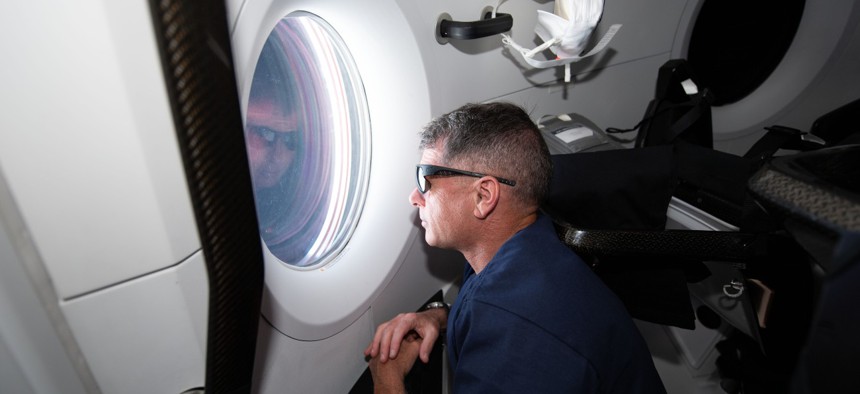
NASA astronaut and SpaceX Crew-2 Commander Shane Kimbrough, looks out the Crew Dragon Endeavour's window during its trip to the International Space Station. NASA photo
Preparing for Re-entry into the Physical Workplace: Lessons from NASA
What NASA knows about the effects of living in relative social isolation for an extended period of time and then adjusting to being around lots of people again.
Astronaut crews living and working in space experience as a matter of course what many of us experienced unexpectedly during the SARS-CoV-2 global pandemic. Consider these similarities:
- They are physically isolated for a long period of time from family, friends, and the majority of their work colleagues.
- Their daily in-person interactions are limited to the few people they live with and their other interactions are intermediated through digital technology.
- Their home also serves as their workplace.
- They are surrounded by a dangerous environment that poses a threat to their physical health. (For them, the dangers include a lack of oxygen in outer space; for us, the danger has been the risk of contracting COVID-19.)
What was new and disorienting in our work lives and personal lives over the past year is the ongoing reality of an astronaut’s day.
So what does NASA know about the effects of living in relative social isolation for an extended period of time and then adjusting upon return to being around lots of people again?
Over the years, my colleagues and I have had the privilege of speaking and teaching at NASA. Their interest in our work has been to help their leaders and managers learn to cultivate a culture of connection so that everyone can give their best performance. They’ve also been interested in how cultures of connection reduce the risk of negative outcomes that arise when people become disconnected and isolated from one another.
Previously, I’ve written about how relational disconnection between NASA engineers and senior managers contributed to the fatal accidents of the space shuttles Challenger in 1986 and Columbia in 2003. Today, with the International Space Station in operation and anticipation of a multi-year human mission into deep space, protecting astronauts from the negative effects of disconnection and isolation has become an issue of greater interest to NASA scientists.
NASA knows that a person’s level of connection affects his or her well-being and performance, and that individual and collective connection is critical to a mission’s success.
The Dangers of Disconnection
Disconnection—which includes isolation (being alone) and loneliness (feeling alone even while in the presence of others)—is unhealthy. For starters, people who are disconnected experience lower sleep quality and diminished self-control to eat healthy and exercise. That sets them up for other problems.
Evidence of unhealthy coping behavior as a result of the isolation and disconnection people have been experiencing during the pandemic is showing up in research findings. The American Psychological Association’s survey of U.S. adults in late February 2021 found that 61% of adults experienced undesired weight changes since the pandemic began, two in three adults (67%) report they have been sleeping more or less than desired, and nearly one in four adults (23%) reported drinking more alcohol to cope with their stress.
On top of changes to our physical health, we’ve had to navigate this period of uncertainty, stress and loss without our emotional and social support systems functioning as they did pre-pandemic. Far too many people lost a family member or friend due to COVID-19 and had to grieve or process the trauma alone. Extended family members couldn’t be on hand to welcome a newborn child, graduates in 2020 didn’t get to cross a stage and receive their diploma to the cheers of the proud audience, and colleagues weren’t together to celebrate the completion of a major project or encourage one another during challenging times. Trauma experts expect the mental health ramifications of the pandemic will rise once the physical threat of COVID-19 declines.
Disconnection and the negative emotions that come with it have been associated with poorer cognitive performance, impairment of executive control and self-regulation, narrowing of awareness and perspective, and lower levels of self-rated physical health. Given these findings, it should come as no surprise that researchers found greater employee loneliness leads to poorer task, team role and relational performance.
Disconnection may also be contributing to the high level of dissatisfaction at work. A recent Microsoft survey of 30,000 individuals worldwide found that 54% believe they are overworked and 39% are exhausted. The pain is sufficiently high that 42% report they are considering leaving their jobs.
Why Connection Matters
As humans, we’re hardwired to connect. Connection makes us smarter, happier, more productive, and more resilient to cope with stress. Teams and organizations with higher levels of connection have higher employee engagement, tighter strategic alignment, better decision making, higher rates of innovation, and greater agility and adaptability. These benefits add up to a powerful advantage. Organizations need a culture of connection in order to thrive for a sustained period of time, a case I make in Connection Culture: The Competitive Advantage of Shared Identity, Empathy, and Understanding at Work.
NASA is intentional about helping astronauts in space maintain connection on multiple levels—as individuals and crew mates. To aid in remembering a set of principles and practices that will protect them from disconnection and the negative effects of isolation, NASA uses the word CONNECT. Their mnemonic device stands for Community, Openness, Networking, Needs, Expeditionary mindset, Countermeasures, and Training and preparation. For example, CONNECT equips astronauts to:
- be aware that their own mental health affects their crew and understand it’s their responsibility to take care of themselves,
- be attentive to how their crew mates are doing and help them if they need it,
- recognize that feeling disconnected may cause them to not want to connect with others, and to ignore that feeling and purposely counteract it,
- reach out proactively in new and innovative ways to maintain connections with family and friends, and also with individuals who energize them and increase their positive emotions, and
- think the best of others so that when someone does or says something that’s disconnecting, it isn’t viewed as having a malicious intent behind it.
Dr. Tom Williams, Element Scientist for Human Factors and Behavioral Performance in the Human Research Program at the NASA Johnson Space Center, goes into greater detail about the actions NASA takes in this podcast.
Another proactive measure NASA employs to protect the mental health and well-being of the astronauts is to have resources available. During the year that astronaut Scott Kelly spent on the International Space Station, he had a scheduled conversation every two weeks with the “brain trust,” a group of psychologists and psychiatrists who helped him cope with isolation. Kelly has said the conversations helped him.
What to Consider as Employees Return to the Office
Reflecting on his re-entry experience after that long mission, Kelly observed, “In my case, returning from space and isolation was instantaneous, shocking, and anxiety-producing. I should’ve eased into it.”
As the current pandemic abates and the world opens up again, educating employees so they understand their human need for connection and what they might experience upon re-entry into a more complex social environment is a proactive step leaders can take. This could be especially important for employees who live alone and have primarily relied on interactions in the workplace to meet their need for social connection.
As you prepare to return to the office, here are three issues to be mindful of:
1. Lethargic Social Skills
“Use it or lose it” is a mantra often employed as motivation to exercise and not neglect our physical fitness. It turns out that our social skills are like muscles, according to research. They too strengthen the more we use them and weaken when we use them less. Figuring out whether we’re physically out of shape is pretty straightforward. But how socially out of shape have we become during the COVID-19 pandemic?
The make-up of the team may not have changed over the past year but how teammates relate to one another has. It’s good to recognize that following an extended period of exercising their in-person social skills less, those skills will have become somewhat diminished for many people. Even if you are an extrovert who is counting down the days until the whole team is seated around the conference table again, don’t be surprised if you too feel a little off your game initially.
What’s going on? It may help people to understand that their unease is triggered subconsciously by their brain and autonomic nervous system. The amygdala, a part of the brain, is constantly monitoring the environment you’re in, assessing if someone or something may be a threat and sending signals throughout your body accordingly. (Think “fight, flight, or freeze.”) Working from home, with perhaps a pet, roommate, or family member occasionally crossing your path and your interactions with colleagues limited to video calls, your brain has grown accustomed to a much different set of stimuli than commuting and having activity all around you in a physical workplace setting. It will need to adjust to reacting to the more complex social environment of being in the physical presence of coworkers once again.
2. Foggy Cognitive Skills
Many people today recognize that the pandemic has had an effect on them, including the onset of brain fog. You’re not alone if you’ve noticed changes in your memory, problem-solving abilities, or attention span. NASA’s twin study found that upon Kelly’s return from his year-long mission in space, he experienced a pronounced decrease in [cognitive] speed and accuracy which persisted for six months. For those wondering if the fog will clear and their previous abilities might return, that’s encouraging news.
3. The Ongoing Need for Connection
Leaders would be mistaken to think they can spend a little time on being social in the first weeks back and then check “reconnect the team” off their to-do list. The need for connection is not a one-time or short-term thing; connection should be the ongoing reality of how a team functions together. And the kind of connection that fires people up and brings out their best is much more than merely chatting about what you did over the weekend or gathering for a slice of cake to celebrate a colleague’s birthday.
To set your team up well for a successful transition period, I encourage you to prioritize addressing the connection deficit that was deepened by the pandemic. One way to do this is through providing online or in-person training to boost connection among employees. In the training, educate people on the harmful effects of loneliness and isolation and the many benefits to individuals and groups that come from tapping into the power of human connection; support them by strengthening their connection and resilience skills and equip them with context-specific attitudes, language, and behaviors that boost connection on their team.
Take Connection Seriously
As discussions are taking place about what work might look like post-pandemic—whether fully in the office or a hybrid approach of remote and in-person hours—leaders would be wise to also carefully consider the relational side of work and what they should do differently on the other side of this collective experience.
Having adjusted to working remotely, you might find that the overall level of engagement people have with colleagues and the organization has waned. Now would be a smart time to infuse the organization’s culture with attitudes and actions that foster connection, energy and enthusiasm. It will also make it easier to bring employees back into the physical workplace if they feel it will be a healthy and engaging environment with colleagues who value them as individuals and give them a voice.
Casting a vision for a culture of connection going forward and then equipping people to make it the norm will help your organization achieve its potential. As NASA knows, the ramifications of not addressing disconnection make it too important to ignore.







